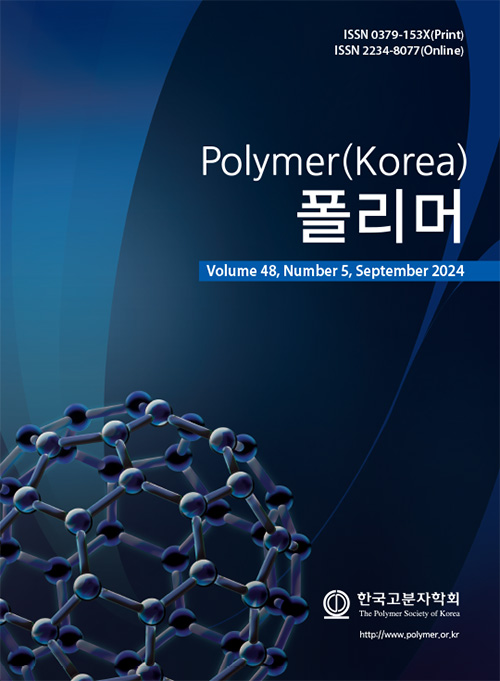- Synthesis of Silicone-Acrylic Emulsions by ARGET ATRP Polymerization and Its Polymerization Kinetics
Xingbing Yang*, **, ***,†
 , Xinye Wang*, Pingting Du*, Shuang Huang*, and Xin Liu*
, Xinye Wang*, Pingting Du*, Shuang Huang*, and Xin Liu**College of Chemical and Chemical Engineering, Sichuan Institute of Arts and Science, Dazhou, 635000, China.
**Special Polymer Materials for Automobile Key Laboratory of Sichuan Province, Sichuan Institute of Arts and Science, Dazhou, 635000, China.
***Key Laboratory of Low-cost Rural Environmental Treatment Technology, Sichuan Institute of Arts and Science, Dazhou, 635000, China.- ARGET ATRP를 이용한 Silicone-Acrylic Emulsion 합성 및 반응속도 연구
Reproduction, stored in a retrieval system, or transmitted in any form of any part of this publication is permitted only by written permission from the Polymer Society of Korea.
Methyl methacrylate (MMA), ethyl acrylate (EA), butyl acrylate (BA) and isooctyl acrylate (2-EHA) were used as the main monomers; γ-methacryloxypropyl trimethoxysilane (KH-570) was used as the silicone functional monomer; a reactive emulsifier and sodium dodecyl sulfate were used as the composite emulsification system; ethyl 2-bromoisobutyrate (EBIB) was used as the initiator; and copper bromide was used as the catalyst. A silicone-acrylic emulsion was prepared by the activators regenerated by electron transfer-atom transfer radical polymerization (ARGET-ATRP) with 2-bipyridine as the ligand and ascorbic acid as the reducing agent. The effects of temperature, initiator, organosilicon and bipyridine on the reaction kinetics were studied, and the polymers were characterized by infrared spectroscopy, gel permeation chromatography (GPC) and nuclear magnetic resonance spectroscopy. When the temperature increased, the conversion and the polymerization rate increased, and the apparent activation energy Ea was 79.65 kJ·mol-1. A greater initiator amount correlated to a higher conversion, a higher polymerization rate and a lower molecular weight. An increase in the amount of silicone increased the conversion and the reaction rate to 0.5% and 1%, respectively. With increasing silicone content, the gel content of the polymer, the molecular weight and PDI increased; when the silicone content was 4%, the polymer could not be dissolved by tetrahydrofuran. The characterization showed that MMA, EA, BA, 2-EHA, KH-570 and the reactive emulsifier SR-10 were all involved in the polymerization. ARGET-ATRP had a controllable molecular weight and narrow molecular weight distribution. Due to the addition amount and cost, few industrial applications exist. Therefore, in this study, the application of ARGET-ATRP on wood paint and the control of the molecular weight of the polymer to meet large-scale industrial application needs were examined.
Keywords: silicone-acrylic emulsion, activators regenerated by electron transfer-atom transfer radical polymerization, polymerization kinetics, emulsion polymerization, activation energy, conversion.
- Polymer(Korea) 폴리머
- Frequency : Bimonthly(odd)
ISSN 0379-153X(Print)
ISSN 2234-8077(Online)
Abbr. Polym. Korea - 2023 Impact Factor : 0.4
- Indexed in SCIE
 This Article
This Article
-
2024; 48(5): 467-474
Published online Sep 25, 2024
- 10.7317/pk.2024.48.5.467
- Received on Jan 30, 2024
- Revised on May 13, 2024
- Accepted on May 17, 2024
 Correspondence to
Correspondence to
- Xingbing Yang
-
*College of Chemical and Chemical Engineering, Sichuan Institute of Arts and Science, Dazhou, 635000, China.
**Special Polymer Materials for Automobile Key Laboratory of Sichuan Province, Sichuan Institute of Arts and Science, Dazhou, 635000, China.
***Key Laboratory of Low-cost Rural Environmental Treatment Technology, Sichuan Institute of Arts and Science, Dazhou, 635000, China. - E-mail: yxb19830528@163.com








 Copyright(c) The Polymer Society of Korea. All right reserved.
Copyright(c) The Polymer Society of Korea. All right reserved.